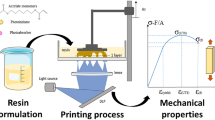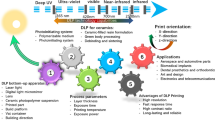Abstract
Soft nanoimprint lithography has been limited to ultraviolet (UV) curable resists. Here, we introduce a novel approach for soft thermal nanoimprinting. Thisunprecedented combination of the terms “soft” and “thermal” for nanoimprinting became possible thanks to an innovative nanocomposite mold consisting of aflexible polydimethylsiloxane (PDMS) substrate with chemically attached rigidrelief features. We used soft thermal nanoimprinting to produce high-resolution nanopatterns with a sub-100 nm feature size. Furthermore, we demonstrate the applicability of our nanoimprint approach for the nanofabrication of thermallyimprinted nanopatterns on non-planar surfaces such as lenses. Our new nanofabrication strategy paves the way to numerous applications that require the direct fabrication of functional nanostructures on unconventional substrates.

Similar content being viewed by others
References
Xia, Y. N.; Whitesides, G. M. Soft lithography. Annu. Rev. Mater. Sci. 1998, 28, 153–184.
Qin, D.; Xia, Y. N.; Whitesides, G. M. Soft lithography for micro- and nanoscale patterning. Nat. Protoc. 2010, 5, 491–502.
Guo, L. J. Nanoimprint lithography: Methods and material requirements. Adv. Mater. 2007, 19, 495–513.
Legrand, D. G.; Gaines, G. L., Jr. The molecular weight dependence of polymer surface tension. J. Colloid Interface Sci. 1969, 31, 162–167.
Jung, G. Y.; Li, Z. Y.; Wu, W.; Chen, Y.; Olynick, D. L.; Wang, S. Y.; Tong, W. M.; Williams, R. S. Vapor-phase self-assembled monolayer for improved mold release in nanoimprint lithography. Langmuir 2005, 21, 1158–1161.
Moran, I. W.; Briseno, A. L.; Loser, S.; Carter, K. R. Device fabrication by easy soft imprint nano-lithography. Chem. Mater. 2008, 20, 4595–4601.
Fan, Z. Y.; Razavi, H.; Do, J.-W.; Moriwaki, A.; Ergen, O.; Chueh, J. L.; Leu, P. W.; Ho, J. C.; Takahashi, T.; Reichertz, L. A. et al. Three-dimensional nanopillar-array photovoltaics on low-cost and flexible substrates. Nat. Mater. 2009, 8, 648–653.
Chen, J. W.; Gu, C. L.; Lin, H.; Chen, S.-C. Soft mold-based hot embossing process for precision imprinting of optical components on non-planar surfaces. Opt. Express 2015, 23, 20977–20985.
Delamarche, E.; Schmid, H.; Michel, B.; Biebuyck, H. Stability of molded polydimethylsiloxane microstructures. Adv. Mater. 1997, 9, 741–746.
Hua, F.; Sun, Y. G.; Gaur, A.; Meitl, M. A.; Bilhaut, L.; Rotkina, L.; Wang, J. F.; Geil, P.; Shim, M.; Rogers, J. A. et al. Polymer imprint lithography with molecular-scale resolution. Nano Lett. 2004, 4, 2467–2471.
Schmid, H.; Michel, B. Siloxane polymers for high-resolution, high-accuracy soft lithography. Macromolecules 2000, 33, 3042–3049.
Odom, T. W.; Love, J. C.; Wolfe, D. B.; Paul, K. E.; Whitesides, G. M. Improved pattern transfer in soft lithography using composite stamps. Langmuir 2002, 18, 5314–5320.
Li, Z. W.; Gu, Y. N.; Wangs, L.; Ge, H. X.; Wu, W.; Xia, Q. F.; Yuan, C. S.; Chen, Y. F.; Cui, B.; Williams, R. S. Hybrid nanoimprint-soft lithography with sub-15 nm resolution. Nano Lett. 2009, 9, 2306–2310.
Richeton, J.; Ahzi, S.; Vecchio, K. S. S.; Jiang, F. C.; Adharapurapu, R. R. Influence of temperature and strain rate on the mechanical behavior of three amorphous polymers: Characterization and modeling of the compressive yield stress. Int. J. Solids Struct. 2006, 43, 2318–2335.
Wang, Z. X.; Volinsky, A. A.; Gallant, N. D. Crosslinking effect on polydimethylsiloxane elastic modulus measured by custom-built compression instrument. J. Appl. Polymer Sci. 2014, 131, 41050.
Chuah, Y. J.; Koh, Y. T.; Lim, K.; Menon, N. V.; Wu, Y. N.; Kang, Y. J. Simple surface engineering of polydimethylsiloxane with polydopamine for stabilized mesenchymal stem cell adhesion and multipotency. Sci. Rep. 2015, 5, 18162.
Lee, J. N.; Park, C.; Whitesides, G. M. Solvent compatibility of poly(dimethylsiloxane)-based microfluidic devices. Anal. Chem. 2003, 75, 6544–6554.
Menahem, L.; Schvartzman, M. Soft nanoimprint mold with rigid relief features for improved pattern transfer. J. Vac. Sci. Technol. B 2017, 35, 010602.
Maex, K.; Baklanov, M. R.; Shamiryan, D.; Lacopi, F.; Brongersma, S. H.; Yanovitskaya, Z. S. Low dielectric constant materials for microelectronics. J. Appl. Phys. 2003, 93, 8793–8841.
Yamazaki, K.; Namatsu, H. 5-nm-order electron-beam litho-graphy for nanodevice fabrication. Jpn. J. Appl. Phys. 2004, 43, 3767–3771.
Bhattacharya, S.; Datta, A.; Berg, J. M.; Gangopadhyay, S. Studies on surface wettability of poly(dimethyl) siloxane (PDMS) and glass under oxygen-plasma treatment and correlation with bond strength. J. Microelectromech. Syst. 2005, 14, 590–597.
McDonald, J. C.; Duffy, D. C.; Anderson, J. R.; Chiu, D. T.; Wu, H. K.; Schueller, O. J. A.; Whitesides, G. M. Fabrication of microfluidic systems in poly(dimethylsiloxane). Electrophoresis 2000, 21, 27–40.
Schvartzman, M.; Palma, M.; Sable, J.; Abramson, J.; Hu, X.; Sheetz, M. P.; Wind, S. J. Nanolithographic control of the spatial organization of cellular adhesion receptors at the single-molecule level. Nano Lett. 2011, 11, 1306–1312.
Schuster, B.-E.; Haug, A.; Häffner, M.; Blideran, M. M.; Fleischer, M.; Peisert, H.; Kern, D. P.; Chassé, T. Characterization of the morphology and composition of commercial negative resists used for lithographic processes. Anal. Bioanal. Chem. 2009, 393, 1899–1905.
Yuan, Q. H..; Yin, G. Q.; Ning, Z. Y. Effect of oxygen plasma on low dielectric constant HSQ (Hydrogensilsesquioxane) films. Plasma Sci. Technol. 2013, 15, 86–88.
Kawamori, M.; Nakamatsu, K.; Haruyama, Y.; Matsui, S. Effect of oxygen plasma irradiation on hydrogen silsesquioxane nanopatterns replicated by room-temperature nanoimprinting. Jpn. J App. Phys. 2006, 45, 8994–8996.
Cai, H. G.; Wind, S. J. Improved glass surface passivation for single-molecule nanoarrays. Langmuir 2016, 32, 10034–10041.
Yang, K.-Y.; Yoon, K.-M.; Kim, J.-W.; Lee, J.-H.; Lee, H. Low temperature fabrication of residue-free polymer patterns on flexible polymer substrate. Jpn. J. Appl. Phys. 2009, 48, 095003.
Liu, M.; Sun, J. R.; Chen, Q. F. Influences of heating temperature on mechanical properties of polydimethylsiloxane. Sens. Actuators A: Phys. 2009, 151, 42–45.
Lötters, J. C.; Olthuis, W.; Veltink, P. H.; Bergveld, P. The mechanical properties of the rubber elastic polymer polyd-imethylsiloxane for sensor applications. J. Micromech. Microeng. 1997, 7, 145–147.
Gates, B. D.; Whitesides, G. M. Replication of vertical features smaller than 2 nm by soft lithography. J. Am. Chem. Soc. 2003, 125, 14986–14987.
Hillborg, H.; Ankner, J. F.; Gedde, U. W.; Smith, G. D.; Yasuda, H. K.; Wikström, K. Crosslinked polydimethylsiloxane exposed to oxygen plasma studied by neutron reflectometry and other surface specific techniques. Polymer 2000, 41, 6851–6863.
Gogolides, E.; Constantoudis, V.; Kokkoris, G.; Kontziampasis, D.; Tsougeni, K.; Boulousis, G.; Vlachopoulou, M.; Tserepi, A. Controlling roughness: From etching to nanotexturing and plasma-directed organization on organic and inorganic materials. J. Phys. D: Appl. Phys. 2011, 44, 174021.
Liou, H.-C.; Pretzer, J. Effect of curing temperature on the mechanical properties of hydrogen silsesquioxane thin films. Thin Solid Films 1998, 335, 186–191.
Chung, S. W.; Shin, J. H.; Park, N. H.; Park, J. W. Dielectric properties of hydrogen silsesquioxane films degraded by heat and plasma treatment. Jpn. J. Appl. Phys. 1999, 38, 5214–5219.
Oh, Y.; Lim, J. W.; Kim, J. G.; Wang, H.; Kang, B.-H.; Park, Y. W.; Kim, H.; Jang, Y. J.; Kim, J.; Kim, D. H. et al. Plasmonic periodic nanodot arrays via laser interference lithography for organic photovoltaic cells with >10% efficiency. ACS Nano 2016, 10, 10143–10151.
Bi, Y.-G.; Feng, J.; Li, Y.-F.; Zhang, X.-L.; Liu, Y.-F.; Jin, Y.; Sun, H.-B. Broadband light extraction from white organic light-emitting devices by employing corrugated metallic electrodes with dual periodicity. Adv. Mater. 2013, 25, 6969–6974.
Jin, Y.; Feng, J.; Zhang, X.-L.; Bi, Y.-G.; Bai. Y.; Chen, L.; Lan, T.; Liu, Y.-F.; Chen, Q.-D.; Sun, H.-B. Solving effici-ency-stability tradeoff in top-emitting organic light-emitting devices by employing periodically corrugated metallic cathode. Adv. Mater. 2012, 24, 1187–1191.
Bi, Y.-G.; Feng, J.; Li, Y.-F.; Zhang, Y.-L.; Liu, Y.-S.; Chen, L.; Liu, Y.-F.; Guo, L.; Wei, S.; Sun, H.-B. Arbitrary shape designable microscale organic light-emitting devices by using femtosecond laser reduced graphene oxide as a patterned electrode. ACS Photonics 2014, 1, 690–695.
Fujita, Y.; Aubert, R.; Walke, P.; Yuan, H.; Kenens, B.; Inose, T.; Steuwe, C.; Toyouchi, S.; Fortuni, B.; Chamtouri, M. et al. Highly controllable direct femtosecond laser writing of gold nanostructures on titanium dioxide surfaces. Nanoscale 2017, 9, 13025–13033.
Xiong, W.; Zhou, Y. S.; He, X. N.; Gao, Y.; Mahjouri-Samani, M.; Jiang, L.; Baldacchini, T.; Lu, Y. F. Simultaneous additive and subtractive three-dimensional nanofabrication using integrated two-photon polymerization and multiphoton ablation. Light Sci. Appl. 2012, 1, e6.
Haynes, C. L.; Van Duyne, R. P. Nanosphere lithography: A versatile nanofabrication tool for studies of size-dependent nanoparticle optics. J. Phys. Chem. B 2001, 105, 5599–5611.
Bates, C. M.; Maher, M. J.; Janes, D. W.; Ellison, C. J.; Willson, C. G. Block copolymer lithography. Macromolecules 2014, 47, 2–12.
Guo, L. J. Recent progress in nanoimprint technology and its applications. J. Phys. D: Appl. Phys. 2004, 37, R123–R141.
Chou, S. Y.; Krauss, P. R.; Renstrom, P. J. Imprint lithography with 25-nanometer resolution. Science 1996, 272, 85–87.
Johnston, I. D.; McCluskey, D. K.; Tan, C. K. L.; Tracey, M. C. Mechanical characterization of bulk Sylgard 184 for microfluidics and microengineering. J. Micromech. Microeng. 2014, 24, 035017.
Kim, B.; Park, M.; Kim, Y. S.; Jeong, U. Thermal expansion and contraction of an elastomer stamp causes position-dep-endent polymer patterns in capillary force lithography. ACS Appl. Mater. Interfaces 2011, 3, 4695–4702.
Cheyns, D.; Vasseur, K.; Rolin, C.; Genoe, J.; Poortmans, J.; Heremans, P. Nanoimprinted semiconducting polymer films with 50 nm features and their application to organic hetero-junction solar cells. Nanotechnology 2008, 19, 424016.
Cecchini, M.; Signori, F.; Pingue, P.; Bronco, S.; Ciardelli, F.; Beltram, F. High-resolution poly(ethylene terephthalate) (PET) hot embossing at low temperature: Thermal, mechanical, and optical analysis of nanopatterned films. Langmuir 2008, 24, 12581–12586.
Juang, Y.-J.; Lee, L. J.; Koelling, K. W. Hot embossing in microfabrication. Part I: Experimental. Polymer Eng. Sci. 2002, 42, 539–550.
Subramani, C.; Ofir, Y.; Patra, D.; Jordan, B. J.; Moran, I. W.; Park, M.-H.; Carter, K. R.; Rotello, V. M. Nanoimprinted polyethyleneimine: A multimodal template for nanoparticle assembly and immobilization. Adv. Funct. Mater. 2009, 19, 2937–2942.
Acknowledgements
This work was supported by Adelis Foundation for Renewable Energy (No. 2021611) and Israel Science Foundation (No. 1401/15). Viraj Bhingardive thanks the Negev-Tsin Scholarship for its support.
Author information
Authors and Affiliations
Corresponding author
Electronic supplementary material
Rights and permissions
About this article
Cite this article
Bhingardive, V., Menahem, L. & Schvartzman, M. Soft thermal nanoimprint lithography using a nanocomposite mold. Nano Res. 11, 2705–2714 (2018). https://doi.org/10.1007/s12274-017-1900-0
Received:
Revised:
Accepted:
Published:
Issue Date:
DOI: https://doi.org/10.1007/s12274-017-1900-0




